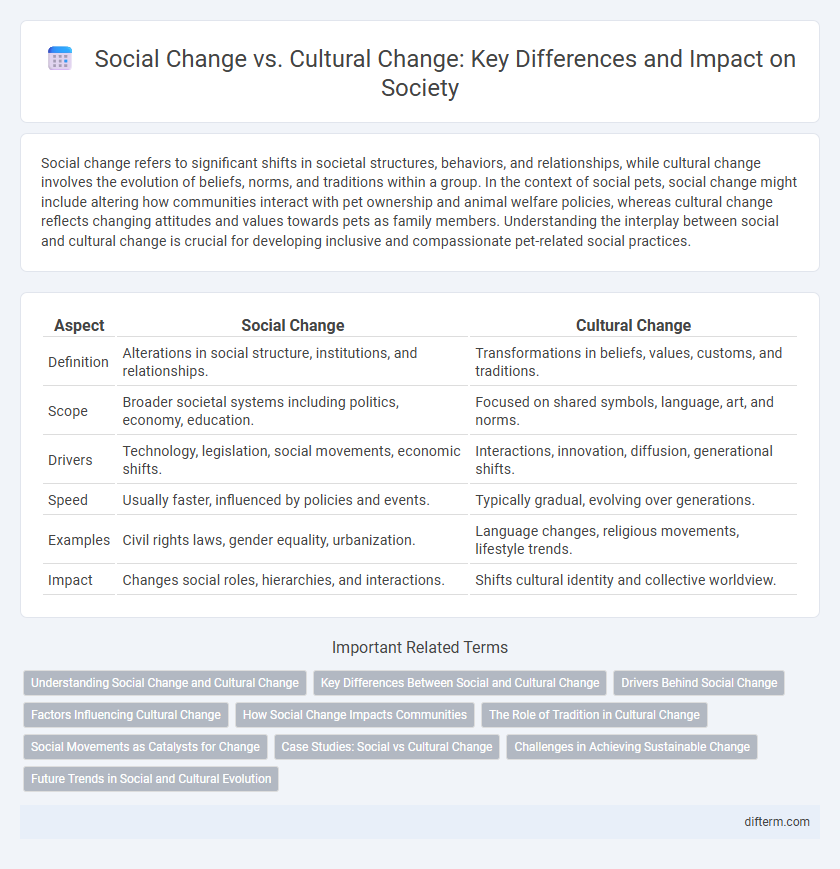Social change refers to significant shifts in societal structures, behaviors, and relationships, while cultural change involves the evolution of beliefs, norms, and traditions within a group. In the context of social pets, social change might include altering how communities interact with pet ownership and animal welfare policies, whereas cultural change reflects changing attitudes and values towards pets as family members. Understanding the interplay between social and cultural change is crucial for developing inclusive and compassionate pet-related social practices.
Table of Comparison
| Aspect | Social Change | Cultural Change |
|---|---|---|
| Definition | Alterations in social structure, institutions, and relationships. | Transformations in beliefs, values, customs, and traditions. |
| Scope | Broader societal systems including politics, economy, education. | Focused on shared symbols, language, art, and norms. |
| Drivers | Technology, legislation, social movements, economic shifts. | Interactions, innovation, diffusion, generational shifts. |
| Speed | Usually faster, influenced by policies and events. | Typically gradual, evolving over generations. |
| Examples | Civil rights laws, gender equality, urbanization. | Language changes, religious movements, lifestyle trends. |
| Impact | Changes social roles, hierarchies, and interactions. | Shifts cultural identity and collective worldview. |
Understanding Social Change and Cultural Change
Social change involves transformations in social structures, institutions, and patterns of behavior within a society, often driven by factors such as technology, economy, or political movements. Cultural change refers to shifts in beliefs, values, norms, and practices among members of a community, influencing identity and social cohesion. Understanding the interplay between social change and cultural change is essential for analyzing how societies evolve and adapt over time.
Key Differences Between Social and Cultural Change
Social change involves transformations in societal structures, institutions, and relationships, such as shifts in laws, economic policies, or social behaviors. Cultural change refers to modifications in beliefs, values, norms, and symbols within a society, influencing language, customs, and traditions. The key difference lies in social change altering the organization and dynamics of society, while cultural change reshapes the collective mindset and symbolic framework.
Drivers Behind Social Change
Technological advancements and economic shifts serve as primary drivers behind social change, reshaping societal behaviors and institutions. Migration patterns and demographic transitions influence the evolution of social norms and collective identities. Social movements and policy reforms play critical roles in accelerating or moderating transformations within communities, differentiating social change from gradual cultural adaptation.
Factors Influencing Cultural Change
Technological advancements, globalization, and shifts in economic structures are primary factors driving cultural change by altering social norms, values, and behaviors. Migration and demographic changes introduce diverse cultural practices, fostering adaptation and hybridization within societies. Media and communication technologies accelerate cultural transformation by shaping public perceptions and disseminating new ideas rapidly across different populations.
How Social Change Impacts Communities
Social change transforms community structures by altering norms, values, and institutions, leading to shifts in social roles and relationships. It influences economic opportunities, education access, and political participation, thereby shaping collective behavior and identity. These changes can foster social cohesion or generate conflict, depending on how communities adapt to new social dynamics.
The Role of Tradition in Cultural Change
Tradition serves as both a foundation and a constraint in cultural change, preserving core values while sometimes resisting rapid transformation. Social change often challenges traditional norms, but meaningful cultural shifts typically emerge through the reinterpretation or adaptation of these established customs. Understanding the dynamic interplay between tradition and innovation is essential to analyzing the pace and nature of cultural evolution.
Social Movements as Catalysts for Change
Social movements act as dynamic catalysts for social change by mobilizing collective action that challenges existing structures, norms, and policies. These movements often invoke cultural change by reshaping beliefs, values, and practices within communities as a response to evolving social demands. By linking grassroots activism with shifts in cultural narratives, social movements drive transformative impacts on societal institutions and everyday life.
Case Studies: Social vs Cultural Change
Case studies of social versus cultural change illustrate distinct dynamics where social change involves shifts in societal structures, such as laws or economic systems, while cultural change pertains to alterations in beliefs, values, and customs. For example, the Civil Rights Movement represents social change by transforming legal and political rights, whereas the gradual acceptance of racial equality in everyday attitudes exemplifies cultural change. Understanding these differences aids policymakers and social scientists in designing interventions that address both structural inequalities and underlying cultural norms.
Challenges in Achieving Sustainable Change
Achieving sustainable social change faces challenges such as resistance from established power structures and deeply ingrained social norms that hinder progress. Cultural change encounters obstacles including the slow adaptation of collective values and identities, which can clash with new social behaviors. Both social and cultural transformations require continuous engagement to overcome these barriers and embed lasting change.
Future Trends in Social and Cultural Evolution
Future trends in social and cultural evolution will increasingly intertwine digital technology and global connectivity, accelerating shifts in values, behaviors, and norms. Social change manifests through movements, policies, and demographics that reshape institutions, while cultural change evolves more gradually via language, traditions, and belief systems. Emerging patterns highlight how artificial intelligence and virtual reality influence both social interactions and cultural expressions, driving dynamic transformations worldwide.
social change vs cultural change Infographic

 difterm.com
difterm.com